Due to the diverse audience, the camera market has many different types of cameras. Whether it’s DSLRs, mirrorless, compact cameras, or even smartphones, they all rely on the core component of photography—the sensor. Different cameras have different sensors. Although we often say that a larger sensor is better, and full-frame is the choice of professional photographers, not everyone needs a large sensor. Especially in today’s technologically advanced world, where non-professional outputs do not require extensive post-processing, the differences between photos have become increasingly minimal. For most non-professional users, whether a camera has a full-frame sensor is often imperceptible; purchasing a camera with a large sensor is more of a psychological comfort.In the film era, there were different sizes of film, including large format, medium format, 135, and even smaller APS and 110 films. In the digital age, this classification has expanded even further. Ignoring the various sensor sizes in smartphones, the types of sensors we frequently encounter in the camera field include one-inch sensors, commonly found in compact cameras like the SONY RX100 series, M43 systems, APS-C sensors, full-frame sensors, and medium format digital cameras.Each standard sensor size has its significance. Larger sensors (this comparison of size is made under the same technology, not considering time; that is, we cannot compare today’s M43 sensors with full-frame sensors from ten years ago) clearly perform better in terms of image quality, high sensitivity, dynamic range, and other metrics compared to smaller sensors. However, this does not mean that it is necessary for every user. When choosing a camera, we need to consider many factors comprehensively to select the camera that best suits our needs.The differences in size between different sensor formats can be visually appreciated through the two images below.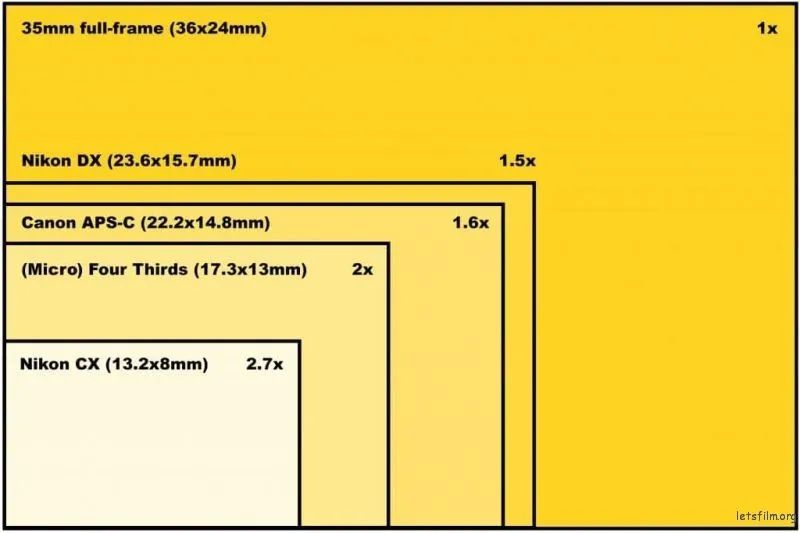
 No sensor is specifically designed for beginners, nor is there a sensor that can only be used by professional photographers. For both professional photographers and amateur shooters, every sensor size can coexist. Moreover, some sensors can even meet specific purposes. Since sensor size is almost always related to specific types of cameras, I will introduce sensors through different types of cameras.Compact CamerasCompact cameras are the small, non-interchangeable lens cameras we commonly see. To be honest, there are not many good compact cameras available now, mainly because the market is too narrow. Previously, the reason for choosing a compact camera was convenience, but this demand has long been replaced by smartphones. Even the once-popular home digital cameras have declined due to the improvement in smartphone photography. Currently, the mainstream option is Sony’s RX100 series, which has updated seven generations since the first generation in 2012. Although the updates feel slow, the 1-inch CMOS sensor still delivers impressive image quality, making it the first choice for those seeking portability with decent image quality.
No sensor is specifically designed for beginners, nor is there a sensor that can only be used by professional photographers. For both professional photographers and amateur shooters, every sensor size can coexist. Moreover, some sensors can even meet specific purposes. Since sensor size is almost always related to specific types of cameras, I will introduce sensors through different types of cameras.Compact CamerasCompact cameras are the small, non-interchangeable lens cameras we commonly see. To be honest, there are not many good compact cameras available now, mainly because the market is too narrow. Previously, the reason for choosing a compact camera was convenience, but this demand has long been replaced by smartphones. Even the once-popular home digital cameras have declined due to the improvement in smartphone photography. Currently, the mainstream option is Sony’s RX100 series, which has updated seven generations since the first generation in 2012. Although the updates feel slow, the 1-inch CMOS sensor still delivers impressive image quality, making it the first choice for those seeking portability with decent image quality.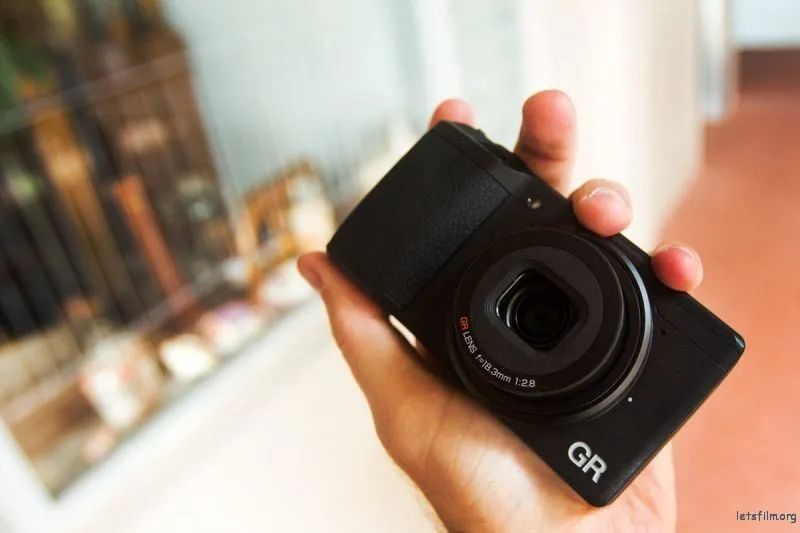 Another classic model is the Ricoh GR, which has a history of over 20 to 30 years, transitioning from film to digital. Although the GR updates very slowly, with the first generation in 2013, the second in 2015, and the third in 2019 (at which point GR enthusiasts lamented the lack of Sony’s update speed), the GR manages to fit an APS-C sensor into such a small body, and its handling is considered a godsend for street photographers.Bridge CamerasIf you frequently visit camera classification websites abroad, you may come across a category called bridge cameras, which may not be popular in China. The definition of a bridge camera is simple: it is a camera positioned above ordinary consumer digital cameras but below DSLRs, designed for advanced users. It acts as a bridge between digital cameras and DSLRs, filling the gap between the two.Bridge cameras typically offer a rich set of manual controls, allowing users to freely select APSM modes, ISO, white balance, and other parameters. However, the most important point is that they do not allow for interchangeable lenses.
Another classic model is the Ricoh GR, which has a history of over 20 to 30 years, transitioning from film to digital. Although the GR updates very slowly, with the first generation in 2013, the second in 2015, and the third in 2019 (at which point GR enthusiasts lamented the lack of Sony’s update speed), the GR manages to fit an APS-C sensor into such a small body, and its handling is considered a godsend for street photographers.Bridge CamerasIf you frequently visit camera classification websites abroad, you may come across a category called bridge cameras, which may not be popular in China. The definition of a bridge camera is simple: it is a camera positioned above ordinary consumer digital cameras but below DSLRs, designed for advanced users. It acts as a bridge between digital cameras and DSLRs, filling the gap between the two.Bridge cameras typically offer a rich set of manual controls, allowing users to freely select APSM modes, ISO, white balance, and other parameters. However, the most important point is that they do not allow for interchangeable lenses.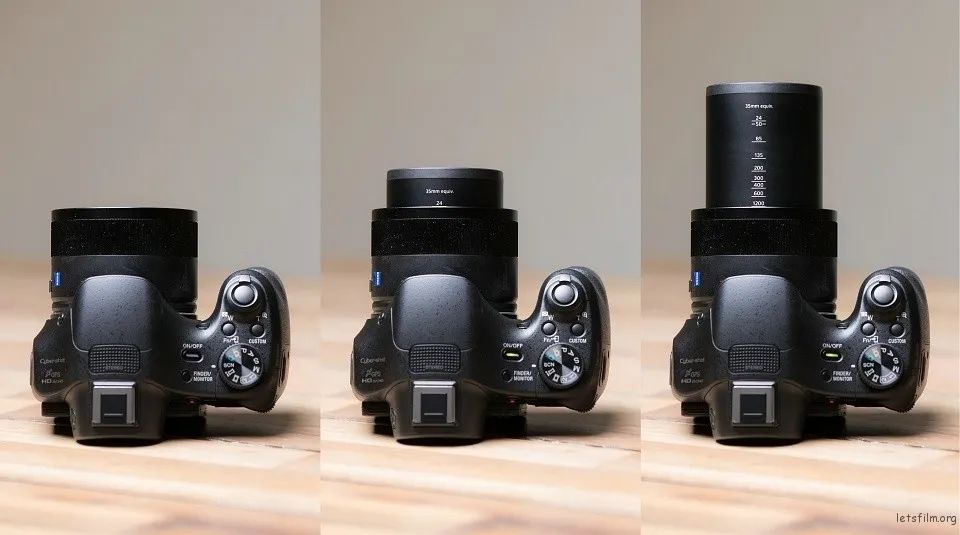 Therefore, the lenses on these cameras generally have a very high zoom range, often exceeding dozens of times. For example, the SONY RX10M4 in the black card series offers a 25x zoom equivalent to a 24-600mm lens, while the lower-end HX-400 provides a 50x zoom lens with an equivalent focal length of 24-1200mm. However, as an entry-level camera, the HX-400 has a pitifully small sensor size of only 1/2.3 inches, which is even smaller than some current smartphone sensors.However, the sensor is not the focus of these cameras; those who choose this type of camera are more interested in having a super telephoto lens to play with. Additionally, their rich control options surpass those of smartphones, and they also resemble DSLRs. In fact, although the sensor is not large, the RX-10 series still delivers decent image quality.M43 SystemIn fact, with various brands now focusing on full-frame mirrorless cameras, the M43 system has lost much of its vitality. The only brand that continues to support the M43 system, Olympus, has even transferred its brand to others for development.The M43 system’s sensor size is exactly half that of full-frame sensors. Since most are interchangeable lens cameras, their size may appeal to those who prefer compact cameras. Due to the 2x crop factor of the lens focal length, it attracts those who enjoy long focal lengths for wildlife photography and have higher image quality requirements.APS-C and Full-FrameWhen digital photography was just starting, the APS-C system became synonymous with entry-level DSLRs. Due to the high cost of full-frame cameras, APS-C cameras became the first choice for beginners wanting to buy a DSLR.The most obvious difference between full-frame and APS-C formats is the field of view. Due to the size difference, the angle of view captured by the same lens will vary. As shown in the image below, we can consider the circular area as the range of the view captured by a lens.The red box represents the size of the full-frame, within which all image information can be captured by the full-frame sensor.The blue box indicates the size of the APS-C format. If using a cropped format, only this area can be captured.
Therefore, the lenses on these cameras generally have a very high zoom range, often exceeding dozens of times. For example, the SONY RX10M4 in the black card series offers a 25x zoom equivalent to a 24-600mm lens, while the lower-end HX-400 provides a 50x zoom lens with an equivalent focal length of 24-1200mm. However, as an entry-level camera, the HX-400 has a pitifully small sensor size of only 1/2.3 inches, which is even smaller than some current smartphone sensors.However, the sensor is not the focus of these cameras; those who choose this type of camera are more interested in having a super telephoto lens to play with. Additionally, their rich control options surpass those of smartphones, and they also resemble DSLRs. In fact, although the sensor is not large, the RX-10 series still delivers decent image quality.M43 SystemIn fact, with various brands now focusing on full-frame mirrorless cameras, the M43 system has lost much of its vitality. The only brand that continues to support the M43 system, Olympus, has even transferred its brand to others for development.The M43 system’s sensor size is exactly half that of full-frame sensors. Since most are interchangeable lens cameras, their size may appeal to those who prefer compact cameras. Due to the 2x crop factor of the lens focal length, it attracts those who enjoy long focal lengths for wildlife photography and have higher image quality requirements.APS-C and Full-FrameWhen digital photography was just starting, the APS-C system became synonymous with entry-level DSLRs. Due to the high cost of full-frame cameras, APS-C cameras became the first choice for beginners wanting to buy a DSLR.The most obvious difference between full-frame and APS-C formats is the field of view. Due to the size difference, the angle of view captured by the same lens will vary. As shown in the image below, we can consider the circular area as the range of the view captured by a lens.The red box represents the size of the full-frame, within which all image information can be captured by the full-frame sensor.The blue box indicates the size of the APS-C format. If using a cropped format, only this area can be captured.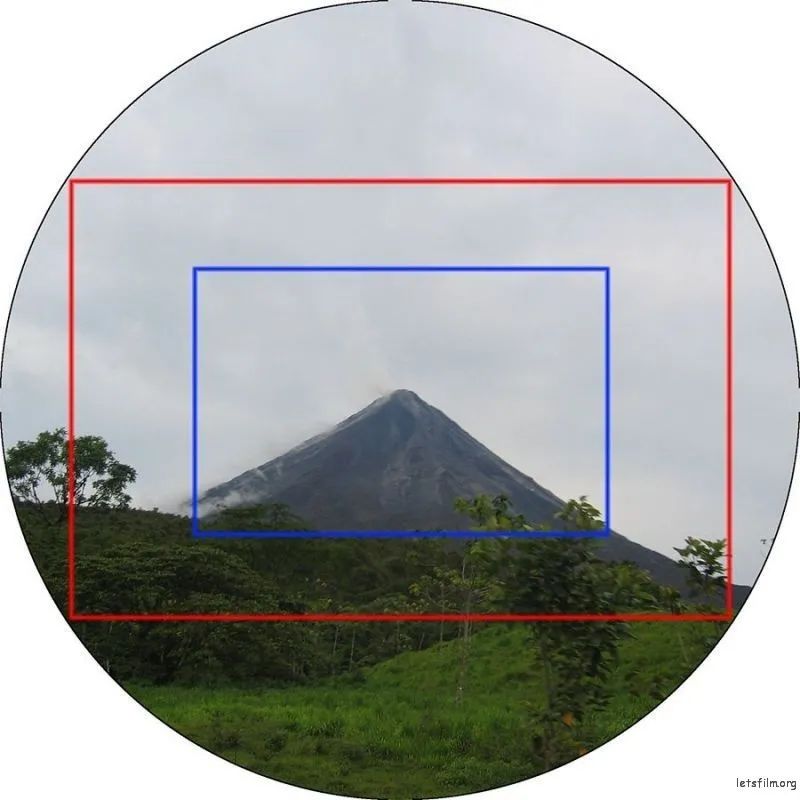 Therefore, the same lens mounted on a full-frame body and an APS-C body will capture different images. On the cropped format, it appears as if the focal length is longer.Thus, when using a cropped format camera, one must consider the focal length conversion factor, which establishes the corresponding relationship between different focal lengths for the same angle of view across different formats.
Therefore, the same lens mounted on a full-frame body and an APS-C body will capture different images. On the cropped format, it appears as if the focal length is longer.Thus, when using a cropped format camera, one must consider the focal length conversion factor, which establishes the corresponding relationship between different focal lengths for the same angle of view across different formats.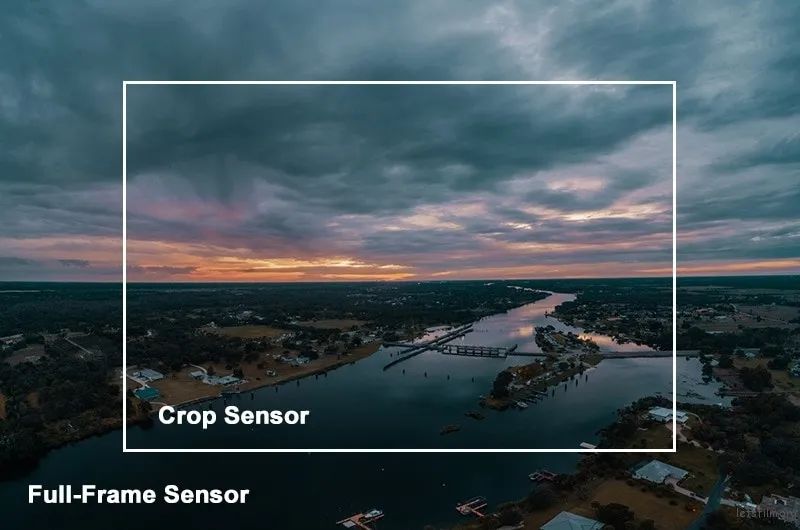 Comparison of Full-Frame and APS-C Fields of ViewIn APS-C format, the focal length conversion factor is 1.5 or 1.6. For example, with a conversion factor of 1.5, a lens with a focal length of around 33mm mounted on an APS-C camera will capture an image roughly equivalent to a 50mm standard lens on a full-frame camera. Therefore, many users of APS-C cameras prefer to use a 35mm lens, as it provides an equivalent view to a standard lens, while a lens around 23mm corresponds to a view of about 35mm on a full-frame camera.If the early differences in image quality between full-frame and cropped formats were vast, today, with smartphones capable of taking good photos, the gap may not be as significant. Some high-end cropped formats perform exceptionally well. For everyday shooting, the differences brought by format are gradually diminishing.Moreover, for those who do not require extensive post-processing or large prints, the differences in image quality are not as pronounced.Of course, if we are professional photographers needing to shoot large photography projects that require extensive post-processing and large prints, a full-frame camera is still necessary.Is full-frame good? Absolutely! It is excellent! The saying that a larger sensor is better is not just a cliché; full-frame can provide finer image quality. Especially for high sensitivity, due to the larger format, at the same resolution, the pixel density of larger sensors is lower than that of smaller sensors, allowing sensor manufacturers more space in electronic circuitry. Therefore, larger formats perform better at high ISO settings compared to smaller formats.However, as mentioned earlier, it still depends on the purpose. If it’s just for everyday shooting and sharing on social networks, and you do not intend to print a wall-sized photo, then sensor size is not a crucial factor. If you are shooting large commercial photography projects or have specific photography plans, it is still necessary to invest in a relatively professional camera for greater versatility. If it’s merely to show off how impressive your camera is, then buy the most expensive one, regardless of whether it performs well; even if it produces results similar to a smartphone, it doesn’t matter, as long as you appear professional in others’ eyes!
Comparison of Full-Frame and APS-C Fields of ViewIn APS-C format, the focal length conversion factor is 1.5 or 1.6. For example, with a conversion factor of 1.5, a lens with a focal length of around 33mm mounted on an APS-C camera will capture an image roughly equivalent to a 50mm standard lens on a full-frame camera. Therefore, many users of APS-C cameras prefer to use a 35mm lens, as it provides an equivalent view to a standard lens, while a lens around 23mm corresponds to a view of about 35mm on a full-frame camera.If the early differences in image quality between full-frame and cropped formats were vast, today, with smartphones capable of taking good photos, the gap may not be as significant. Some high-end cropped formats perform exceptionally well. For everyday shooting, the differences brought by format are gradually diminishing.Moreover, for those who do not require extensive post-processing or large prints, the differences in image quality are not as pronounced.Of course, if we are professional photographers needing to shoot large photography projects that require extensive post-processing and large prints, a full-frame camera is still necessary.Is full-frame good? Absolutely! It is excellent! The saying that a larger sensor is better is not just a cliché; full-frame can provide finer image quality. Especially for high sensitivity, due to the larger format, at the same resolution, the pixel density of larger sensors is lower than that of smaller sensors, allowing sensor manufacturers more space in electronic circuitry. Therefore, larger formats perform better at high ISO settings compared to smaller formats.However, as mentioned earlier, it still depends on the purpose. If it’s just for everyday shooting and sharing on social networks, and you do not intend to print a wall-sized photo, then sensor size is not a crucial factor. If you are shooting large commercial photography projects or have specific photography plans, it is still necessary to invest in a relatively professional camera for greater versatility. If it’s merely to show off how impressive your camera is, then buy the most expensive one, regardless of whether it performs well; even if it produces results similar to a smartphone, it doesn’t matter, as long as you appear professional in others’ eyes!
